For all the noise about the Cubs’ issues throughout the 2017 season, and there were real issues, the club finished with an offense approximately 73 runs better than Wrigley Field / 2017 National League. While this is quite a decline from the monstrous +103 RS the Cubs posted during their storybook 2016 campaign, there is no mistaking the fact that the Lakeview Nine were an elite offense. Yet the upstart Brewers managed to give the Cubs hell, most visibly by shredding Cubs pitching (Milwaukee scored 88 runs in 19 games against the North Shores, six full runs better than one would expect against the Cubs’ season average pitching). However, while the lopsided whippings may stick in Milwaukee fans’ memories, the Brewers pitching held the Cubs bats well below their typical runs scoring output; in 19 games, the 2017 Cubs would be expected to score 96 runs, but they only managed to score 84 against the Brewers arms.
Against the mighty Cubs, then, the Brewers went +6 RS / +12 RA compared to an average distribution of the Cubs seasonal Runs Scored and Runs Allowed. Compared to the Brewers’ own performance, Milwaukee went +2 RS / -3 RA against the Cubs based on an average distribution of their seasonal Runs Scored and Runs Allowed. On balance, this means that the Milwaukee Nine held their own against the vastly superior Cubs, which was evident throughout the tense September series in which the Brewers forced a divisional conversation and nearly made the playoffs.
Brewers fans are largely complaining about the state of the club’s Winter Meetings, as the club is expected to improve pitching but came away from the meetings without any new starting pitchers or relievers. Obviously, the offseason is very young, and Stearns himself has shown a penchant for working deep into the offseason: see the Khris Davis trade in February 2016, as one example, or even the bullpen-depth-defining Jared Hughes signing entering 2017. But even as fans fret about a rotation featuring Chase Anderson, Zach Davies, Junior Guerra, Brent Suter, and Brandon Woodruff to enter 2017, it is worth remembering the performance against the Cubs to frame the potential of this group of arms. Specifically, it was the unassuming Davies (and, arguably, equally unassuming Anderson and Suter) that strung together some of the best outings against the Cubs.
In fact, selecting a biased sample of these four pitchers’ best starts against the Cubs, a 58.7 IP, 15 runs (2.30 runs average!), 47 strikeout / 11 walk / 4 home run performance appears. Despite a 47 RS / 28 RA (!!!) team performance in these ten, Milwaukee’s bats and bullpen unfortunately failed to support the starters in some of these games, resulting in a 6-4 record despite the successful starting pitching (Milwaukee went 3-6 in the other nine games versus the Cubs with a much worse 41 RS / 56 RA performance).
| Date | Pitcher | Line | Outcome |
|---|---|---|---|
| 17-Apr | Anderson | 5.0 IP / 3 R (5 K / 1 BB / 0 HR) | 6-3 W |
| 6-Jul | Davies | 6.0 IP / 2 R (3 K / 0 BB / 1 HR) | 11-2 W |
| 28-Jul | Suter | 7.0 IP / 0 R (5 K / 1 BB / 0 HR) | 2-1 W |
| 29-Jul | Guerra | 3.0 IP / 0 R (4 K / 4 BB / 0 HR) | 1-2 L |
| 30-Jul | Davies | 7.0 IP / 3 R (6 K / 0 BB / 1 HR) | 2-4 L |
| 9-Sep | Anderson | 5.0 IP / 0 R (5 K / 1 BB / 0 HR) | 15-2 W |
| 10-Sep | Davies | 7.0 IP / 1 R (6 K / 1 BB / 0 HR) | 3-1 W |
| 21-Sep | Davies | 7.0 IP / 2 R (3 K / 2 BB / 1 HR) | 3-5 L |
| 23-Sep | Suter | 5.3 IP / 1 R (2 K / 0 BB / 0 HR) | 4-3 W |
| 24-Sep | Anderson | 6.3 IP / 3 R (8 K / 1 BB / 1 HR) | 0-5 L |
| 10 Games | 58.7 IP / 15 R (47 K / 11 BB / 4 HR) | 47-28 (6-4) |
Selecting the successful games obviously presents a biased image of performance, but it is worth diving into these starts in order to see how the Brewers succeeded. In what follows, it will be clear that the Brewers succeeded by adjusting throughout the year against the Cubs, and (for the most part) sticking with extremely balanced pitch selection approaches against the monstrous Cubs offense. What is meant to result from this study is increased fan confidence in the approach of the pitchers along with the catching staff, coaches, and (probably) team baseball research department. The Brewers undoubtedly had a lot go right in 2017, and if no baseball season can be successful without luck, the Brewers were particularly lucky in their convergence of events. But, luck does not explain the full story, as across the board a group of relatively unknown or unheralded players quietly gave hell to the most hyped team on the Senior Circuit.
This is not to suggest that the Brewers will have continued success against Cubs bats simply by working in similar zones, but rather that these Brewers processes of dancing throughout the zone from start to start could continue to orient these arms for seemingly surprising success. Indeed, the Brewers arms already improved by 26 runs between the first and second half of 2017, thanks to a 4.11 runs average in August, capped off with 3.64 runs average in September/October. Milwaukee is a pitching-first club, and the nails approach against the Cubs demonstrates one of the keys to that success.
The image of Zach Davies conjures a sinker-change up starter who constantly works low in the zone. What’s intriguing about Davies’s success against the Cubs throughout 2017 is that the righty consistently worked up into the zone to offset his low, sinking change up and blooping curve. Moreover, the righty’s additional pitch, what Brooks Baseball calls a “Cutter” but could be somewhere between a traditional cut fastball and slider, became one of the balancing aspects of his approach with the Cubs. The “cutter” itself for Davies is an interesting pitch, one that the young righty first expanded in 2016, and then shifted slightly in 2017; the PITCHf/x readings are slight, but essentially in 2017 Davies was using the pitch to “run” slightly more armside and rise slightly more than the 2016 version. Unlike 2016, Davies basically evened out his exceptional change up and big curveball, an arsenal change that churned out more groundballs and whiffs from the cutter in 2017.
Here are Davies’s four best starts against the Cubs. The shifts are subtle, but it’s clear that the righty was changing his approach with each meeting against the Cubs simply based on pitch selection. But these aren’t wholesale changes, instead (like the pitcher) they went on-a-bit, off-a-bit, adding and subtracting subtly to find a successful approach with each start. By the end of the year, the approach was working wonders for the righty.
| Davies | Sinker | RunningFB | Cut/Slide | Change | Curve |
|---|---|---|---|---|---|
| 6-Jul | 52 | 6 | 14 | 17 | 13 |
| 30-Jul | 35 | 8 | 20 | 18 | 16 |
| 10-Sep | 37 | 1 | 17 | 17 | 17 |
| 21-Sep | 36 | 9 | 18 | 6 | 8 |
Davies did not simply rely on pitch selection to baffle the Cubs, however. The righty consistently changed his approach within the zone for each start, including challenging the Cubs up in the zone with both fastballs and breaking balls. According to Brooks Baseball, here are the four best Davies starts versus the Cubs in terms of total zone migration:
By separating Davies’s sinker and fastball, as well as his cutter, change, and curveball, one can isolate the specific areas of the zone in which the righty was attempting to work “hard” and “soft.” Here are Davies’s sinker and the occasional fastball:
I grouped Davies’s “cutter” with the change and curve, because I’m simply not certain that it works like an additional “hard” pitch for Davies. The righty’s arsenal is beginning to look like that of Shaun Marcum at his best (a very good thing, remember Marcum was a 12.1 WARP starter from 2007-2011), meaning that the righty can provide armside- and gloveside-breaking pitches, while also essentially changing speeds on his “sinker” (with the change up) and “fastball” (with the cutter), making the curveball the “great” equalizer. Against previous scouting reports, size questions remain for Davies, although he has remained particularly durable in each of his advanced seasons thus far, and he is succeeding beyond the expected back-end starter “Overall Future Potential (OFP)” role because of his ability to adjust at the MLB level and due to his new cutter.
The cutter is typically the breaking pitch that Davies throws “uo” in the zone, with the curve and change dropping low. This gives Davies the distinct advantage of working three different velocity levels through different areas the zone:
What is striking about both migrations throughout the zone is that Davies does not simply “climb the ladder” with the hard stuff as time progresses, but he also locates his “breaking” and “off speed” offerings higher in the zone from time-to-time, too. As a result, Davies is essentially going straight after Cubs batters, and despite their acumen for power, they were largely unable to hit the righty as the season wore on. This could be an effective mindgame from Davies, insofar as he has established himself as someone who not only prefers to work low in the zone but also is perceived to be someone who cannot come into the zone to challenge batters. One might question whether batters’ lack of expectation for pitches within the zone allowed Davies to have an advantage for pounding those areas with strikes. Indeed, he was rather successful throughout these four starts in terms of limiting hits:
Notice that by the last start against the Cubs, despite locating heavily throughout the zone and especially gloveside (to your right on the GIF), the Cubs simply did not end AB in those zones, and did not collect hits in those areas.
Like Davies, Chase Anderson’s success in 2017 swirled around a cutter and a curveball, although those tow pitches mean two different things for both arms. Anderson has become slightly more of a “velocity” pitcher, ramping his fastball from roughly 92 MPH in 2014 to nearly 94 MPH in 2017, and he famously revamped his curveball and cutter under the watch of pitching coach Derek Johnson. With a new grip, and increased usage of both the curve and cutter (at the expense of the change and other fastballs), Anderson upped the whiffs and groundballs on the curveball within the system of his new arsenal.
What is interesting about Anderson is that while one might expect Davies to be the wily pitch shifter, against the Cubs Anderson’s five-pitch arsenal moved in a more extreme manner than that of Davies. With the added velocity, Anderson effectively looks like a cross between a pitch-bending trickster and a classic over-the-top power pitcher:
| Anderson | RisingFB | RunningFB | Cutter | Change | Curve |
|---|---|---|---|---|---|
| 17-Apr | 25 | 19 | 12 | 18 | 13 |
| 9-Sep | 16 | 20 | 8 | 10 | 12 |
| 24-Sep | 31 | 16 | 17 | 10 | 21 |
| Total | 72 | 55 | 37 | 38 | 46 |
From start to start against the Cubs, Anderson also migrated his pitching approach throughout the zone. Here are the righty’s three best starts against the Cubs. Notice the total overall migration from armside-to-gloveside zone approaches, especially the sharp overall pitch location contrast between the two September starts:
Within these overall migration patterns, Anderson’s distinct alignment of the cutter / fastballs approach and off-speed stuff is a beautiful thing. Unlike Davies, I lumped Anderson’s cutter in with his fastballs, simply because Anderson has a less distinct fastball queue than Davies (who throws a true “sinker”), as Anderson’s “moving” fastball is more like a hard running, riding pitch than a sinker. That his cutter is also nearly 90 MPH makes that pitch much closer to Anderson’s original fastball velocity, and easier to classify as a true cut fastball. Watch as Anderson stacks up the Cubs gloveside with hard stuff in his first September start, then dilutes the hard pitches throughout the zone:
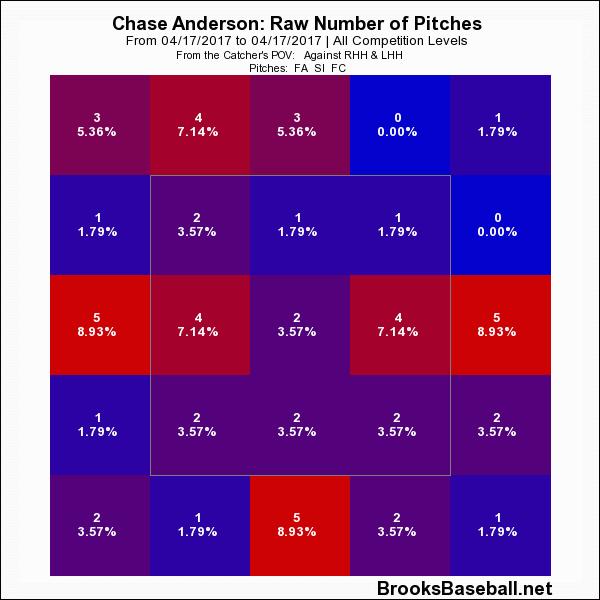
What’s stunning with Anderson’s fastball / off-speed pitching approach is how he completely splits the two classifications of pitches throughout the zone. Granted, this would happen somewhat with Davies as well if the cutter is treated like a fastball instead of a breaking ball, so it is worth bearing this methodological decision in mind. Still, Anderson’s split is quite extreme, as shown in his first September start: with fastballs and cutters blaring in gloveside, Anderson whips those off-speed pitches to the armside of the zone. Once again, this is a beautiful type of dispersion, as once the Cubs have this start in mind, during their second look at Anderson later in the month, he completely moves his off-speed pitches gloveside.
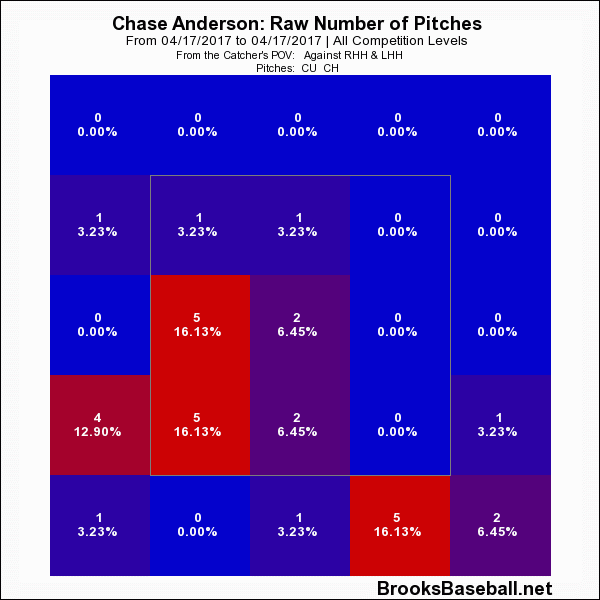
Like Davies, Anderson effectively used these moving selections to limit hits from Cubs bats:
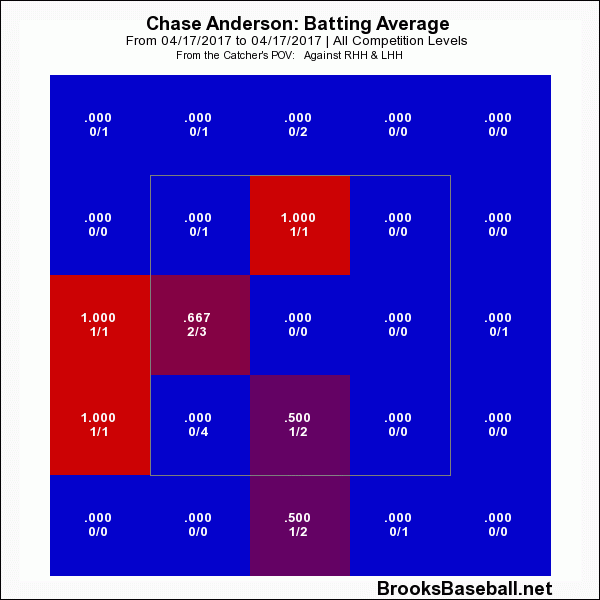
With Brent Suter and Junior Guerra, there are fewer starts available, and therefore less room to compare their respective arsenals.
| Suter | Fastball | Change | Slider | N.A. |
|---|---|---|---|---|
| 28-Jul | 55 | 17 | 10 | n.a. |
| 23-Sep | 41 | 15 | 14 | n.a. |
| Guerra | RisingFB | RunningFB | Slider | Split |
| 29-Jul | 21 | 18 | 13 | 9 |
So let’s just appreciate that Suter throws his 86 MPH fastball as his majority pitch (he is NOT a junkballer), and that he also consistently used his fastball to challenge Cubs bats high in the zone:
With the lefty’s insistence against squaring up when he releases the ball, Suter’s high fastball must be an uncomfortable sight. Imagine the Raptor’s arms rotating at you, and then instead of a top-down delivery, the southpaw slings the ball around his body while also pushing it high in the zone. This is a beautiful pitch, and it’s also worth questioning whether Suter is really just throwing a cutter; from time to time, the Raptor throws that pitch in a way to break “in” on righties, which is precisely what he did in both starts against the Cubs.
Not to be outdone, Guerra’s post-injury work against the Cubs revealed a bizarre variation of his splitter, where the off-speed pitch actually flattened out and seemed to flutter as a “straight change up” to the plate. Guerra often seemed to have no idea where the bizarre splitter would run, as the pitch sometimes dropped, sometimes rose, and sometimes simply landed on a straight line like Rich Harden’s ghost pitch:
It should not be viewed as a cliche that the Brewers beat the Cubs because their best pitchers consistently adjusted against Chicago bats. It’s not a truism that MLB players succeed by adjusting; they succeed by adjusting, and at times when the adjustments don’t work, the struggles can be difficult to turn into effective performances. The Brewers succeeded with a gang of unheralded pitchers, in the form of swingman Suter, old rookie Guerra, “back-end” Davies, and replacement level Anderson. But none of this quartet was what they were supposed to be during the 2017 season, in part because of their ability to use flexible approaches to maximize their tools. Davies maximized his approach by coming after presumably unsuspecting batters high in the zone, while Anderson maximized his approach by running vast migrations throughout the strike zone. The difficulty of this approach is that while it is true that Milwaukee will once against need these pitchers to adjust to succeed in 2018, their adjustments may not necessarily mimic their 2017 success; new or changed pitches may emerge, new pitch sequencing, or velocity questions (or surpluses) may also impact zone approaches.
At the very least, the ability to adjust in 2017 should cause Brewers fans and analysts not to count out this unsuspecting rotation prior to 2018.
Photo Credit: Dennis Wierzbicki, USAToday Sports Images.
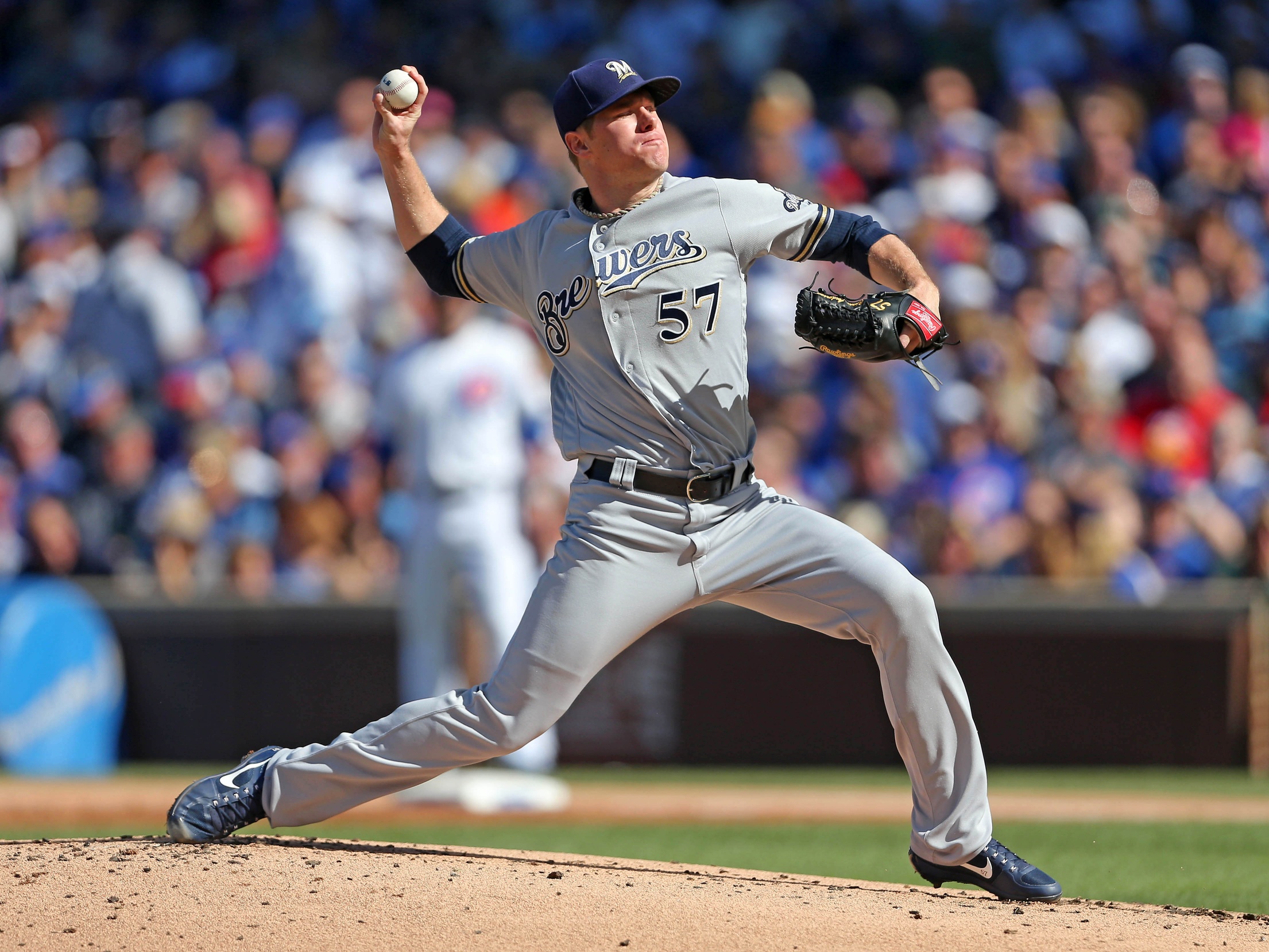

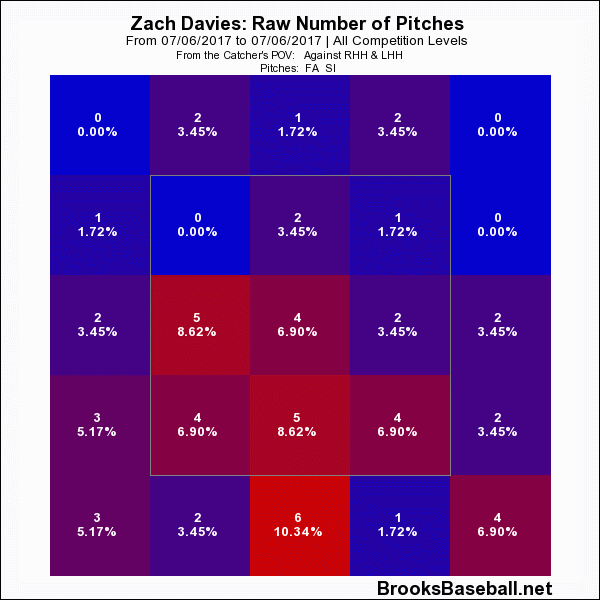
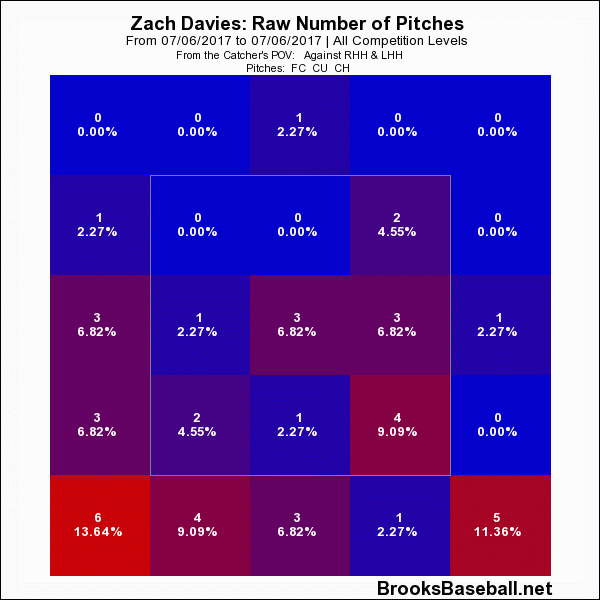

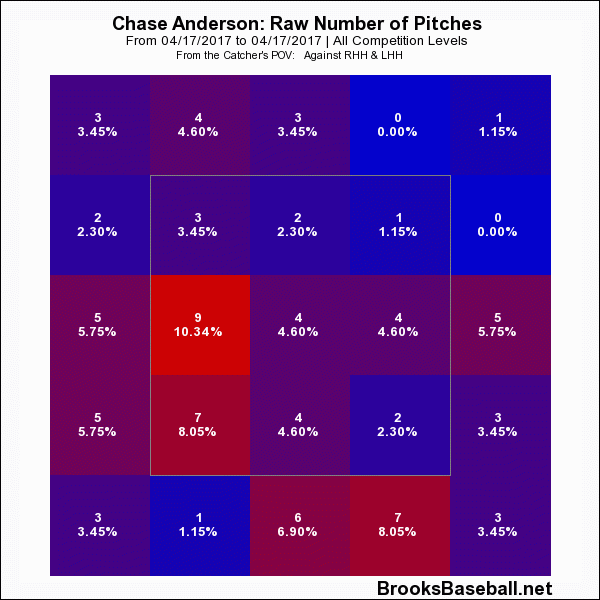
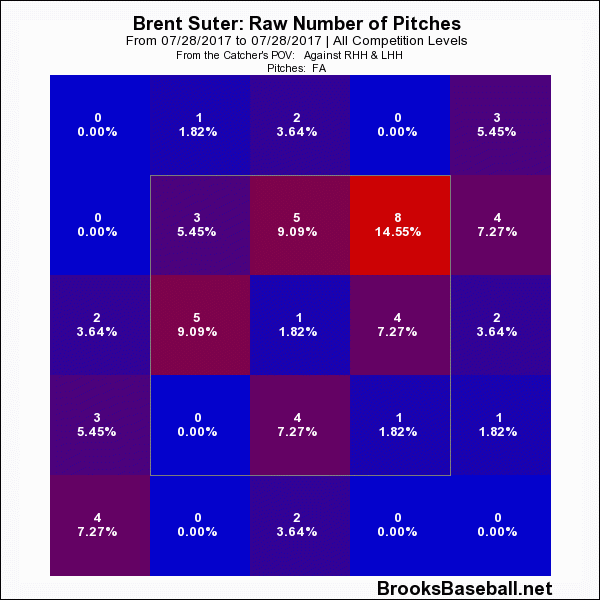
Great breakdown. I have always thought the Cubs prey on cobblers. I think the fact that our pitching coach worked in the Cubs system is also a factor. I would guess that the Brewers threw many more pitches in the zone than any other team against the Cubs. We need to keep DJ at all cost.
That’s a great point — there’s got to be a way to verify the strike zone hypothesis, I’ll see what I can find. But I think it goes to show just how “throw good strikes” is not a truism — that’s really how you beat batters, even elite ones.
I listened to Roy Oswalt on MLB network and he talked about how being aggressive as a pitcher, throughout the count, is fading. The Cubs, Dodgers, Yankees and Ref Sox want to grind out ABs. Why not throw 3 straight strikes to them?
When everyone is going left it is tough to find the treasure! I think the Brewers are moving right and using an aggressive strategy against the Cubs.
Nibblers not cobblers. No shoe makers on our staff.